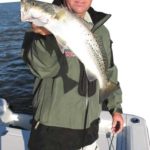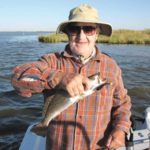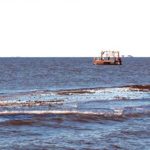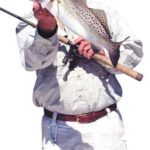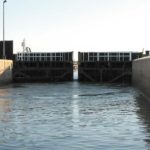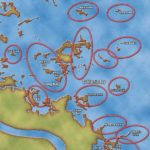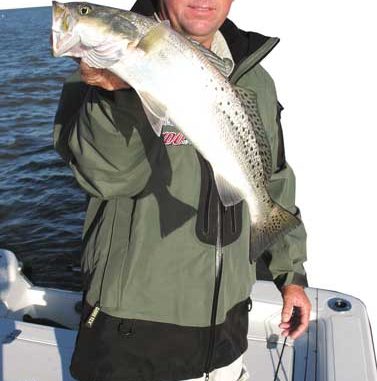
Make your first stop of the day the outside waters on the east side of the Mississippi River, and the trout you return with will make inside anglers green with envy.
I know, conventional wisdom dictates that in the winter, you fish the inside waters for speckled trout and redfish. And everybody knows that trout make a transition twice a year — in the spring, they head out to the big waters on the edge of the Gulf, and in the fall, they move inside and take up residence in the deeper canals and bayous where they ride out the winter.
All of this is common knowledge among trout anglers, accepted by all and disputed by none.
Or so I thought.
Actually, there are quite a few anglers who believe you can catch big trout in the outside waters all year round. Some of these seasoned anglers insist that big trout hang out along the edges of the coast throughout the entire winter.
I have to admit, I always suspected that I could make the long haul to the coast and find trout outside in the winter, but I’ve always stayed closer to the dock once the fish transition to the inside. Why make the long run just to see if fish were out there when I knew there were fish in close?
But when Capt. Nash Roberts IV (504-650-1918) invited me on an outside trip to catch big wintertime trout, it was too much to resist.
The wind blew hard from the west all night before the trip, and I worried that Roberts might call and pull the plug on the trip altogether.
But the weatherman predicted better things for the next day, and sure enough, the morning broke with cloudy skies and kinder winds.
My long-time fishing partner, Sal Scurria, and I met Roberts at the dock of the Delta Marina in Empire just after daybreak, and quickly piled our gear into his 22-foot BlackJack. I noted that the marina store and cabins appeared undamaged by this season’s hurricanes (either that or they were already back in pristine condition), while Roberts pulled into the Empire Locks and we waited for the back set of gates to close and the gates on the river side to open.
Minutes later, we sped along the river toward the non-functioning Ostrica Locks, and once through them, we made the quick run into Quarantine Bay. We pulled up to a nearby point on a small spit of land. Roberts pushed the button, and the PowerPole stuck us to the bottom.
“The water is a bit muddy,” Roberts commented, “but west winds will do that.”
He was confident there were fish in the area, and he pointed to a space about 10 to 20 feet off the point and said for us to cast there.
We were fishing strictly with soft plastics, and Scurria asked Roberts what color he thought would produce best under the conditions.
“Fish with any color you want, as long as it’s black or purple,” Roberts answered.
He opened a bag of black/chartreuse Cocahoes, and invited us to use what we needed.
“I mostly always use black/chartreuse, and whenever I do switch colors, it’s to purple/chartreuse,” he said. “These colors produce consistently every month of the year, so why change.”
However, I was already baited up with an Old Bayside in the new penny color on a ¼-ounce plain jighead, so I tossed it out into the area Nash suggested, and had an immediate hookup. I reeled in a 16-inch trout, and tossed right back to the same spot and caught another of identical size.
From then on, the action was non-stop for a solid half-hour. We seldom made a cast and retrieve without a hit, and most hits resulted in a good hookup. These 15- to 16-inch fish weren’t the huge trout we were hoping for, but they sure proved Nash’s theory: The trout don’t all migrate to the inside.
“I honestly couldn’t tell you where these trout go when it gets cold,” Roberts said. “I suspect they simply go deep and stay dormant until the cold front passes and the sun comes out and warms everything up again.
“But what I do know is they don’t all migrate to the inside. A lot of these fish, including the bigger fish, stay out here all winter long. And in the mild, pre-front or post-front days, you can catch them right here along these reefs and islands.”
Scurria and I were amazed that we were catching all these fish in such shallow, cloudy water in the winter.
“Believe it or not, when the conditions are right, the outside is actually the best place to fish in the winter,” Roberts said. “I often find that on calm days the fish just don’t bite on the inside. It can really be frustrating to have a picture-perfect day, calm winds and mild temperatures, and you can’t get on a decent bite. That’s exactly the kind of day you want to head to the coast.
“Just pick your days, and fish before the fronts come through. Then, on those calm days, head to the outside and fish at islands and reefs. Ignore the rigs and wells, and work the shallow reefs because that’s where the fish will be.”
Roberts says the whole Quarantine Bay and California Bay areas will be hot in December, and points and reefs from California Point all the way to Iron Banks and Stone Island and everywhere in between are good places to try.
Our action slowed, and though the trout were still biting, we decided to explore a few nearby islands and reefs to see what we could find. As we hunted, we saw several other boats fishing in the same area, and recognized most of them as guides from the west side of the river. There were also perhaps a couple boats from the Pointe a la Hache launch, and all of them made it obvious that fishing outside in the winter certainly is no secret.
In fact, Capt. John L. Taylor (985-397-4383), another west-side captain, regularly makes the run across the river to the east side throughout the winter.
“Generally, I fish the west side on an east wind and the east side on a west wind,” he said. “You want to head over to the points and islands on calmer, moderate-weather days, either before the fronts move through or a few days afterwards. Then I head over toward California Point, Kelly’s Gap, Mangrove Point, Sunrise Point and Pelican Point, and I work that general area.
“If the weather is still pretty cold, I try to fish closer to the river. For some reason, I find the fish move closer to the river when it’s cold. But you have to find clean water, and unless the river drops some more, that might be difficult to do.”
Taylor says the river so far this year has shown a tendency to hang stubbornly to higher-than-usual levels that keep the water muddy instead of that green water anglers hope to see because of the explosive fishing action it brings.
Meanwhile, Roberts bounced us around to a few other reefs and islands where we tried to hide from the rapidly building winds and seas. Unfortunately, our fishing action was deteriorating along with the weather conditions, and finding clear water became a challenge. We did find a few more trout, some on the hefty side but still not the big ones we hoped for, and we landed a nice redfish that couldn’t resist our baits.
Roberts says there are plenty redfish still hanging along the coastline, and anglers who fish the pre- or post-front days can usually find them in the mix along with the specks. Anglers can also focus on reds by casting up close to shorelines with the same soft plastics or with gold spoons, beetle-spins or market shrimp under a cork.
Roberts also hooked a very nice doormat flounder that was sitting on a flat looking to ambush unwary baitfish. Unfortunately, the big flatfish shook the hook and escaped before we could get a net under him. (Note to self: Always net flounder. They are experts at shaking off when you try to lift them into the boat. And I was so looking forward to baked flounder stuffed with crabmeat!)
So, as for the conventional wisdom? Yes, the trout do migrate to the inside in the fall, and our own experience proves it. But not all the trout move inside. Many of them and, according to Roberts, the bigger trout, hang outside, where on those calm and mild days before the fronts blow through and cause the temperatures to plummet, they’ll be found slamming baits along the broken islands and reefs on the edge of the big water.
Capt. Nash Roberts IV can be reached at (504) 650-1918.
